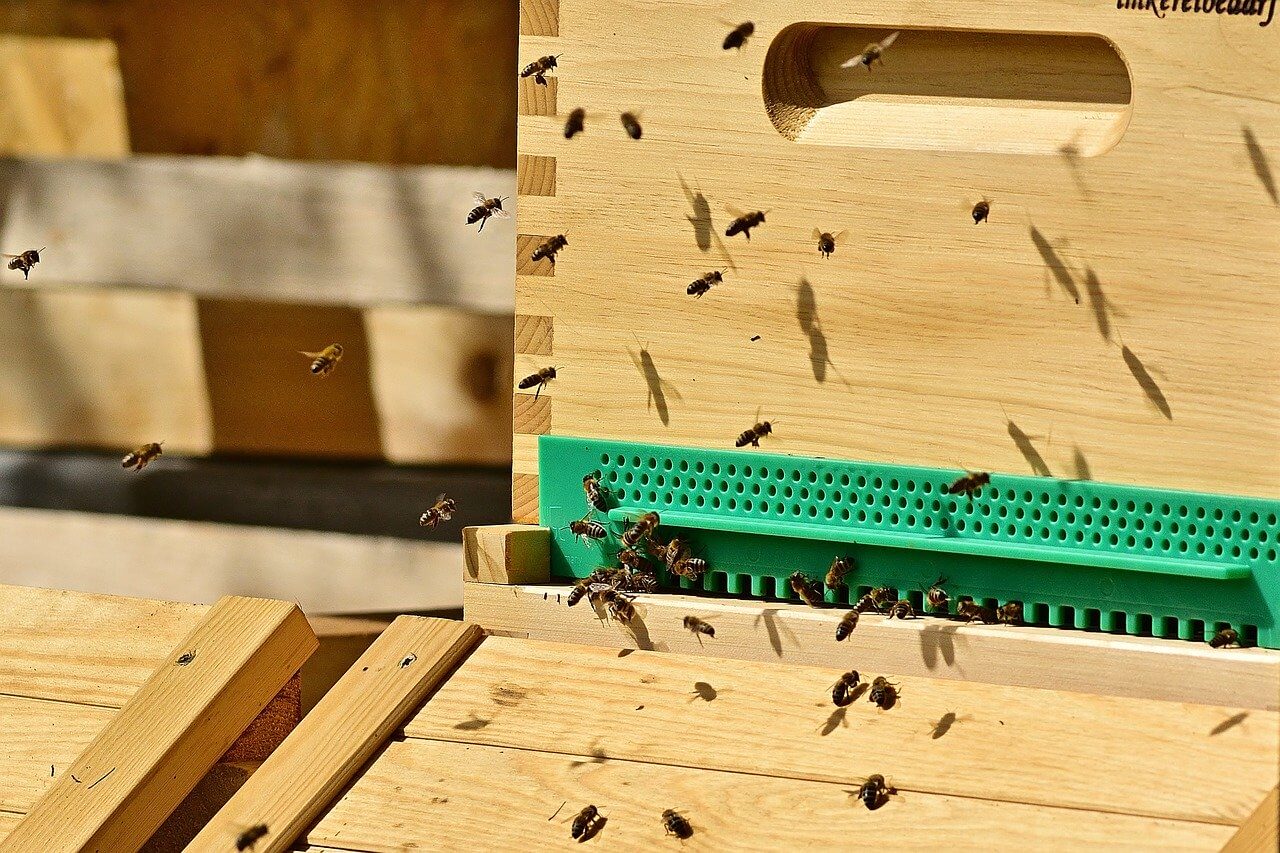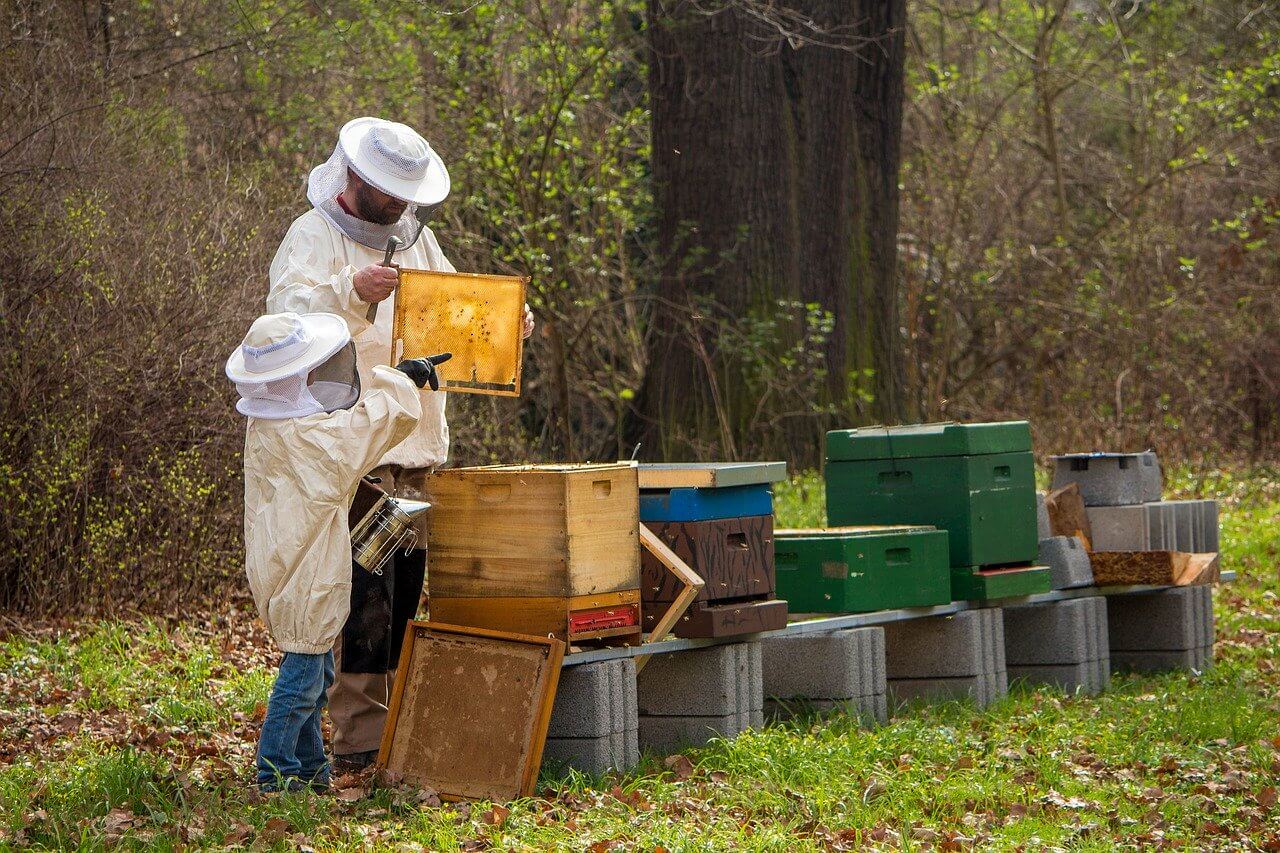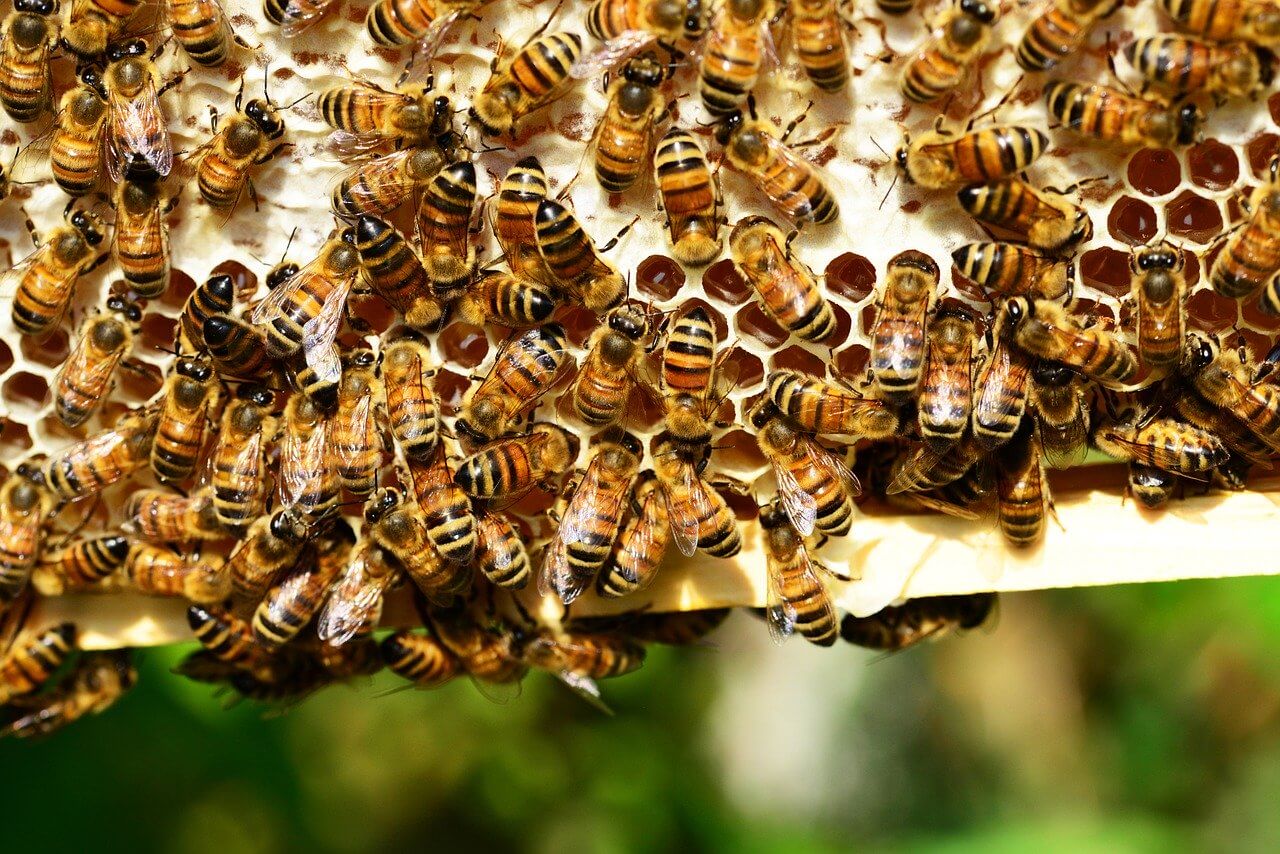A thriving bee colony stores up plenty of honey to meet its winter needs, so in the best case scenario, your bees will not need extra food provided during the wintertime. Unfortunately, for the last few years weather conditions have been unpredictable and less than ideal around the globe. This situation often leaves bee colonies without sufficient stored food to get them through the winter. In this article, we provide sound advice on what to feed bees in winter. Read on to learn more.
What You'll Learn Today
- How Much Food Do Bees Need In Winter?
- What Should You Feed Bees In The Wintertime?
- What Should You Avoid Feeding Bees In The Wintertime?
- Will HFCS Negatively Impact The Quality Of Honey?
- How Do You Provide Bees With Wintertime Food?
- When Should You Provide Wintertime Feed For Bees?
- How Do You Know Your Bees Are Getting Enough To Eat?
- Frequently Asked Questions
- Q: Can‘t bees live through the winter without being fed?
- Q: How do you know how often and how much to feed your bees in wintertime?
- Q: If your colony has scarce stores, how can you make sure it‘s ready for winter?
- Q: Are candy boards the only way to provide bees with extra food in winter?
- Q: How do you use plain, dry sugar to feed bees?
- Q: How should you store sugar, syrup or honey for feeding bees?
- Q: How do you prepare sugar syrup for bees?
- Q: How do you give bees sugar syrup?
How Much Food Do Bees Need In Winter?

It’s important to understand that bees can starve during the winter even if they have enough food because food in the hive can become inaccessible to them.
It’s essential that you inspect your hives regularly in winter to be sure that your bees can get to the food they have in storage throughout the wintertime.
The amount of stored honey a colony of bees needs during the wintertime depends a great deal on local weather conditions and the climate.
The type of bee and the number of bees in the hive also affects the amount of stored food that is needed.
It’s important to continue giving your bees supplemental food in the early spring time because sometimes bees can make it through the winter eating their stored honey and additional food provided by you and then die in the springtime, nonetheless.
When this happens, it’s because they’ve eaten most of their stored or provided food during the very coldest months and then starve during the in-between time when the stored food runs out but flowers have not yet started to produce nectar.
What Should You Feed Bees In The Wintertime?

Your bees will do best with their own honey provided as additional food during the autumn and in the wintertime.
If you don’t have extra honey to give them, make them a simple sugar syrup using plain white table sugar. The syrup should be one part water and two parts sugar.
Of course, if your area experiences extremely low temperatures this syrup will freeze. In this case, you should use dry, granulated sugar, candy boards, sugar cake or fondant.
Remember that white sugar doesn’t contain any micronutrients, so you’ll need to include a feeding stimulant made with essential oils.
This will give your bees some extra nutrients. Pro Health and Honey-B-Healthy are examples of commercial products that can be used for this purpose.
What Should You Avoid Feeding Bees In The Wintertime?
If your bees are to eat honey in the winter, it should be their own honey or honey from a close by and trusted source. Honey that comes from an unknown source may carry disease spores that could sicken or kill your bees.
You can feed your bees sugar, but it must not have any additives. For example, brown sugar is made with molasses, and some types of commercial sugar may include coloring or flavoring.
None of these are acceptable for bee feeding and could cause honeybee dysentery.
Some beekeepers say that high fructose corn syrup (HFCS) is an acceptable food for bees, but you should be aware that it can contain an ingredient called hydroxymethylfurfural (HMF).
This toxic ingredient may be present in syrup that has been stored at a temperature that is too high. It also develops in old syrup.
Furthermore, HFCS is a dreadful, artificially made product that is very detrimental to human health. It is hard to imagine that it would be beneficial to bees.
Read also: When Should I Treat My Bees For Mites?
Will HFCS Negatively Impact The Quality Of Honey?
Keep in mind that feeding HFCS or sugar syrup is intended as a stopgap measure to prevent bees from starving during the wintertime. These products are not typically fed to bees in active honey production. For this reason, feeding HFCS should not negatively impact honey quality.
How Do You Provide Bees With Wintertime Food?

If you live in an area where the winters are very cold, you have several choices:
- Feed using a candy board.
- Feed using a mount camp rim.
- Fill a shallow super with sugar cakes.
In areas where the wintertime temperature inside the hive is higher than 50°F, you can use an internal liquid feeder. This will enable your bees to eat inside. Note that you may need to add mold inhibitor to the mix.
When Should You Provide Wintertime Feed For Bees?

If your hive seems hungry and feels light in the autumn, begin feeding sugar syrup as described above very early in the autumn. When the weather gets very cold and drops below 50°F, change to a cold-weather method.
It’s better to feed your bees a little bit in advance of winter than to let them get hungry. Proactive feeding can help prevent a number of problems.
Even if your bees have a good store of their own honey, it’s smart to also give them sugar cakes as insurance.
This will allow them to eat sugar cakes and honey through the entire winter to stretch their supply of honey.
Giving them access to both honey and sugar helps ensure that they get the nutrients they need.
How Do You Know Your Bees Are Getting Enough To Eat?
Wellness checks must continue throughout the winter. Whenever you have a sunny, dry day, you should check on your bees and make sure that they’re doing all right.
Be certain that clusters of bees have not become isolated from frames of honey. If you see that this the case, make adjustments to be certain that they can get to the food that they have.
Which Is Better, Beet Sugar Or Cane Sugar?
Either beet or cane sugar is perfectly acceptable for feeding bees. One caveat, though, is that sugar beets may have been genetically modified so as to be “Round-Up Ready.”
If you want to stay away from GMOs, you may wish to seek out cane sugar.
How To Feed Bees In Winter & Fall
Frequently Asked Questions
Q: Can‘t bees live through the winter without being fed?
A: Wild honey bees have to live through the winter (or not) without supplemental food. In nature, survival of the fittest is the decider, so bees that produce lots of extra stores of honey and are not ransacked by bears and other hungry critters survive harsh conditions and produce more offspring to carry on their wise, industrious, thrifty genes. Domestic honey bees are raised and cared for by humans. As such, they must be fed through the winter when there are no natural sources of nectar and pollen. As a beekeeper, it is your responsibility to care for and nurture your tiny charges and to protect your investment. If you don’t provide your bees with extra food during lean and hungry times, they may very well starve to death.
Q: How do you know how often and how much to feed your bees in wintertime?
A: You can begin light supplementing late in the autumn, even if your bees have their own good stores for the winter. You must inspect your hives regularly (once every two or three weeks) during the winter to see how much honey they have stored and how much they have used. When supplemental food gets low, replace it. Don’t worry too much about it going bad, as the high sugar content and cold temperatures should keep it fresh; however, if it starts to look the worse for wear (or if it smells at all) change it. When flowers begin to bud, cut back on feeding. When flowers bloom, stop feeding.
Q: If your colony has scarce stores, how can you make sure it‘s ready for winter?
A: Always inspect your hives on a regular basis. If you see that a hive is not well prepared for winter, go ahead and give it a generous amount of supplemental nourishment early in the autumn and keep these bees well stocked with extra food throughout the winter. It’s much better to give too much than too little.
Q: Are candy boards the only way to provide bees with extra food in winter?
No, there are a few ways you can make sure your bees have enough to eat in the wintertime:
- If you are able to, you may relocate your hives to warmer areas where natural sources of nectar and pollen are available all winter long.
- If you have a source of disease free honey, or you have kept honey from your own hives, you can feed this to your bees in winter. Note that supermarket honey is not necessarily disease free.
- In a pinch, you can feed plain, white table sugar, but you mustn’t do this all winter. Remember that bees also need pollen in order to thrive.
- It is also possible to supplement bees’ nourishment with a liquid syrup made from white table sugar. Again, you cannot consider this a complete food.
See our article on candy boards for more information on preparing wintertime nourishment for your bees.
Q: How do you use plain, dry sugar to feed bees?
A: You would place dry sugar just under the hive lid on a hive mat or tray. If your colony is fairly strong and has a fair amount of honey set by for winter, it can do pretty well with supplemental dry sugar feedings during the spring and the fall when there is ample moisture in the air. During the winter, the air may be too dry for bees to be able to liquefy the dry sugar and make use of it. Weak colonies may have trouble utilizing dry sugar even during damper weather. In any event, always be sure your bees have access to fresh, clean water.
Q: How should you store sugar, syrup or honey for feeding bees?
A: Never leave any of these substances out in the open where they might attract stray bees and other insects and pests, which can introduce disease to your colony. Always keep your bee feeding supplies in sealed, pest-proof containers stored in a cool, dry location.
Q: How do you prepare sugar syrup for bees?
A: Generally speaking, a 50/50 mix of sugar and very hot water makes a good supplemental source of nourishment for bees. If the honey stores in your hive are very low, you can increase the amount of sugar in the mix making it two-thirds sugar and one-third water. The hot water helps the sugar dissolve and mix evenly in the water. Naturally, you should allow the mixture to cool thoroughly before giving it to your bees. Note that you should not boil the mix because this can cause the syrup to caramelize and become toxic for your bees. Very hot water will work just fine.
Q: How do you give bees sugar syrup?
You can offer sugar syrup in:
- Container feeders with sealable lids, which you can make yourself using a container such as a plastic peanut butter jar.
- Plastic bag feeders, which you can also make at home using a plastic freezer bag.
- Shallow trays that are the right size to fit under the hive lid can be used.
- Special, purpose made frame feeders may also be used.
For details on how to use each of these, the Australian government has prepared a nice information sheet (https://agriculture.vic.gov.au/livestock-and-animals/honey-bees/health-and-welfare/feeding-honey-bees-to-prevent-starvation)
Thank you a lot for these useful tips. They seem like working for my bee colony.
Where can I buy one of the plastic freeman trays?
It looks like the name brand Freeman trays may only be available in hardwood from various beekeeping suppliers and sources such as eBay. There are also some beekeeping sites that offer plans to build your own. Plastic versions can be found on Amazon.